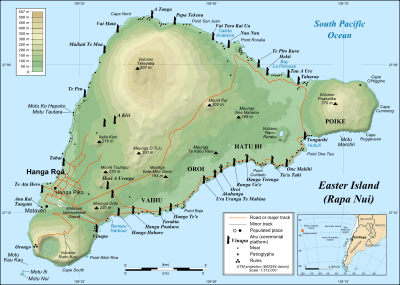Poike
Main article: Easter Island § Geology

The north side of Poike seen from the west

Rapa Nui showing Poike at the eastern (right) side of the island
Poike is one of three main extinct volcanoes that form Rapa Nui (Easter Island) (a Chilean island in the Pacific Ocean). At 370 metres, it is the island's second highest point after Terevaka.
Poike forms the eastern headland of Rapa Nui, and there is an abrupt cliff "the Poike ditch" across the island marking the boundary between flows from Terevaka and Poike. Poike last erupted between 230,000 to 705,000 years ago in the Pleistocene, and as the oldest of Easter Island's three volcanoes is the most weathered with relatively stoneless soil.
See also
- List of volcanoes in Chile
- List of volcanoes in Pacific Ocean
References
- Haase, Karsten M.; Stoffers, Peter; Garbe-Schönberg, C. Dieter (October 1997). "The Petrogenetic Evolution of Lavas from Easter Island and Neighbouring Seamounts, Near-ridge Hotspot Volcanoes in the SE Pacific". Journal of Petrology 38 (06): 785–813. doi:10.1093/petrology/38.6.785. Retrieved 2010-03-16.
- ROUTLEDGE, Katherine. 1919. The Mystery of Easter Island. The story of an expedition. London.
- VAN TILBURG, Jo Anne. 1994. Easter Island: Archaeology, Ecology and Culture. Washington D.C.: Smithsonian Institution Press.
External links
- Guide to Easter Island from the Easter Island Foundation
Coordinates: 27°05′31″S 109°15′00″W / 27.09194°S 109.25000°W